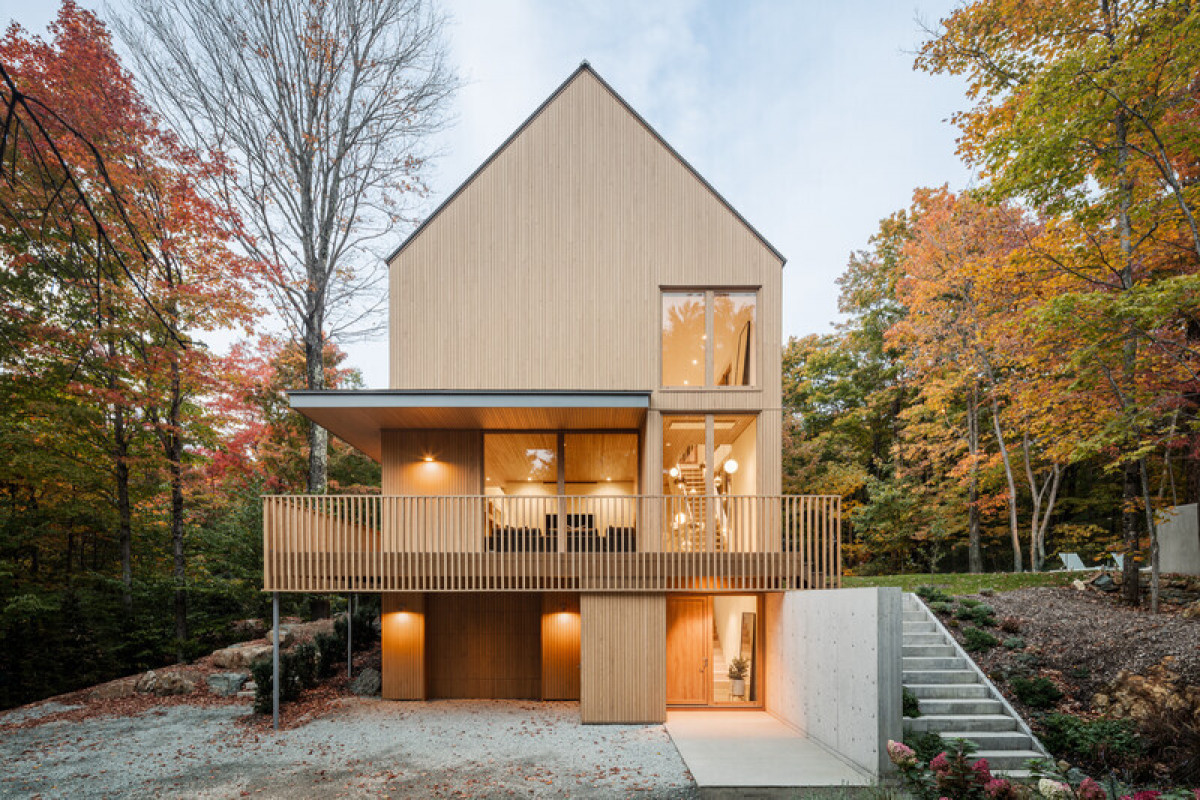13 Aug 2024

This single-family dwelling is located in the heart of the Eastern Townships, right next to Parc National du Mont-Orford. Neighbouring a few disparate residential buildings, it is immersed in mountainous terrain, where maple and fir trees stretch as far as the eye can see. Taking full advantage of this exceptional setting, it offers its residents a spectacle that evolves with the seasons, from the blazing colours of autumn to the verdant awakening of spring.
The couple had owned the land for over 5 years when they called on Thellend Fortin Architectes to build their second home. At the time, an old building occupied the site but was no longer suitable for the family's needs. However, the parents and children remained attached to this corner of paradise, where they shared many memories and hobbies. Lush nature, breathtaking mountain views, cultural and physical activities at their fingertips: it was out of the question for them to leave. So the decision was made to demolish the old place and rebuild in its footsteps.
Several sketches will follow between the first discussions and the owners' move-in, to ensure the realization of a project that meets their needs - that is, to have a privileged place where family and friends can get together as close to nature as possible. Starting from the concept that everything is already present on the site and that nothing needs to be added, the architects will face several challenges during the design process, among them:
A comprehensive work was carried out on the three components of architecture, interior design, and landscape to define a coherent language, combining the "warm and chic" atmosphere desired by the owners, and the functional approach of contemporary architecture. Double-sloped roofs, wood cladding, and metal cladding assimilated to zinc take up the codes of vernacular vocabulary about the province's built heritage.
The elementary geometry of the project is animated by a play of solids and voids, projections and recesses, alternating more protected and more open areas. The dominant verticality is emphasized by the rhythm of the wooden slats and facade openings, and counterbalanced by a series of horizontal gestures - notably the projection of the canopies and perimeter gallery. Combined with these elements, the tight railings of the guardrails lift the gaze towards the distant landscape.
The site's topography is exploited to design a promenade winding gently between the trees. This promenade leads from the public road onto private land to serve the residence and its garden pavilion (including the summer lounge and outdoor pool), before rising to surround the main building. The clients' desire for a "majestic" entrance on the lower floor is reflected in the double height of the reception hall. This double height, combined with a passageway under the overhanging terrace, marks the contrast between outside and inside, the sensation of being nestled in the forest and that of being drawn towards the sky.
Within the residence, the garden level, first floor, and bel étage follow one another, in analogy with the tripartite composition of the woodlands.
A sculptural metal staircase links the three floors in a single fluid movement, evoking that of a folded sheet of paper. The diagonal it draws, unique within the project, makes it a highlight of the user's spatial experience.
Specific finishes subtly support the contrast between the interior and exterior using a summary palette of materials. On the exterior, metal panels, wood cladding, and concrete slabs present a raw appearance and matte finish. Inside, reflective surfaces such as waxed concrete, varnished joinery, polished marble, and glass walls maximize natural light. Sober, light hues, from white to shades of grey, combine with the natural warmth of oak floors, ceilings, and window frames.
The majority of furnishings, such as worktops and storage units, are integrated into the architectural project, with a constant concern for coherence and simplicity. Technical elements such as heating and lighting are concealed behind wall coverings and false ceilings, the former combined with an underfloor heating system.
The environmental approach favours logical and rational solutions, in keeping with the spirit of the project and its context. Locating the new building on the foundations of the old one ensures minimal impact on the site. The conservation of existing elements is put at the service of the project, the landscaping is enriched by the presence of mature trees, and the topography contributes to contribution in the sequencing of spaces. The building's compactness maximizes energy gains, despite its large surface area.
All these features, combined with a fair, no-frills architectural and landscape proposal, ensure the building's longevity, without involving the deployment of out-of-scale technologies. Coherent from start to finish, thought through in every aspect from its integration into the vast landscape to the smallest hardware detail, the Orford house ensures the comfort of its inhabitants with the utmost respect for nature.
Technical sheet